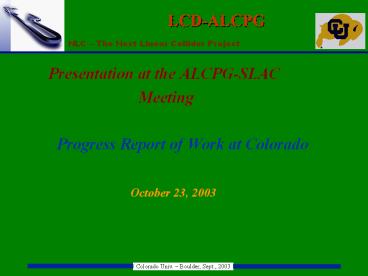LCD-ALCPG PowerPoint PPT Presentation
Title: LCD-ALCPG
1
LCD-ALCPG
- Presentation at the ALCPG-SLAC
- Meeting
- Progress Report of Work at Colorado
- October 23, 2003
2
LCD-ALCPG
- THE GROUP
- Shirley Choi, Bradford Dobos, Tyler Dorland,
Eric Erdos, - Jeremiah Goodson, Jason Gray, Andrew
Hahn, - Alfonso Martinez, Uriel Nauenberg, Joseph
Proulx - 2 new freshmen 2 high school
students
3
LCD-ALCPG
- ACTIVITIES
- Simulation of Supersymmetry. New method to
overcome the negative effects of beamstrahlung
and bremmstrahlung. - Develop a new geometrical structure in
calorimetry that is cost effective and will have
the energy and time resolution required in a
Linear Collider environment.
4
LCD-ALCPG
- Simulation of Selectron Production
- Case Study
- Consider Case SPS3 , M1/2 400 GeV.
- Mass of eR 178.3 GeV, Mass of eL 287.1 GeV,
Mass of ?01 160.6 GeV. - Compare Fits with Beam and Bremmstrahlung and
without. - We use the e - e - Energy Spectra Substraction
Technique to remove Standard Model Background.
5
LCD-ALCPG
- Selectron Production
- e - e - Energy
Spectra
6
LCD-ALCPG
- Resultant Fits to Energy Edges
- No Bremm
Bremm
7
LCD-ALCPG
- New Method to Determine Masses
- Compare Energy Spectrum to those Generated with
different parameters encompasing the correct one. - Do a Chi Square Fit to the Spectra Comparison.
- Choose the minimum and determine the masses.
8
LCD-ALCPG
M1/2 400 , expected value.
M1/2 1.5 from 400
9
LCD-ALCPG
- Chi Square Fit Distribution
-
-
M1/2(expec.) 400 GeV -
M1/2(fit)400.220.19 GeV
-0.54
10
LCD-ALCPG
- Activities for Coming Year
- Apply method to Smuons to look for the left
handed smuon with and without positron
polarization. - Apply method to Neutralinos. SUSY background can
now be included in the fit since this background
also varies with the parameters. - This is a multi-year effort.
11
LCD-ALCPG
- Scintillator tile layers 5 x 5 cm2, 2mm thick.
- Alternate layers are offset. See next slide.
- Effective 2.5 x 2.5 cm2 spatial resolution.
- Reduces by 25 the number of channels when
compared to 1 cm2 tile structures.
The Calorimeter
12
LCD-ALCPG
- The Basic Geometrical Structure
13
LCD-ALCPG
- The Tile Arrangement
14
LCD-ALCPG
- The Calorimeter test unit we have built
- Cosmic
Ray Trigger
15
LCD-ALCPG
- The Calorimeter in the Black Box
16
LCD-ALCPG
- New Readout Equipment
- We have LabView Installed.
- University money.
- We are purchasing Readout from National
Instruments or Acqiris. Probably it will be
National Instruments. Bids. - Had a demonstration yesterday, very impressive
what one can do. - We already know we have problems with
calorimeter low pulse height from cosmic muons.
It is time to have fun investigating. - A lot of work in the near future.
-
17
LCD-ALCPG
- Simulation of Energy Resolution
- We have simulated 2 mm, 1 mm scintillator
- thicknesses and 35, 40 ,45 layers.
18
LCD-ALCPG
- Simulated Energy Resolution
- 45 layers, 2mm
scintillator, 1/2X0 Tungsten
19
LCD-ALCPG
- Caveat
- Dependence of Simulated Resolution on GEANT
Propagation Cut-Off
Cut Used
20
LCD-ALCPG
Conclusions on Energy Resolution
- Energy Resolution of 11/E1/2 achievable.
- This resolution has been confirmed by Italian
group working in Frascati.(Checcia). - Need 2 mm thick scintillator and 45 layers.
- Need to study further whether increasing the
thickness of Tungsten of the last 5 layers will
allow us to reduce the number of layers while
maintaining the resolution.
21
LCD-ALCPG
Issues on Spatial Resolution
- Moliere Radius
- Comparison of Photons Spatial Resolution with
no offset case - Resultant Spatial Resolution Comparison
- Net Mass and Jet Directional Resolution
- Can we Separate Hadrons from the Shower
- Energy Flow Resolution of 2.5 x 2.5 cm2 versus 1
cm2 tile structures.
22
LCD-ALCPG
- Standard Dev. of the Shower Energy
Distribution - 5 Gev Photon 75
GeV Photon Shower ? of Dist. vs P
23
LCD-ALCPG
- Moliere Radius
- The Moliere Radius is defines as containing 90
of the - Energy. This is roughly equivalent to 1.63 x ?
1.63 x 1.5 - Moliere Radius 2.5
cm.
24
LCD-ALCPG
- Spatial Resolution
1 dimension(z)
d(?)?(?)
25
LCD-ALCPG
- Mass of the
Z0? e e - No Offset
Offset
26
LCD-ALCPG
- Energy Scale Constant
- 15 GeV, 30 deg.
5GeV, 45 deg.
27
LCD-ALCPG
- Directional Biases in the Shower Fit
- red 00 dip angle
blue 450 dip angle
28
LCD-ALCPG
- After 1st order Corrections
29
LCD-ALCPG
- Distance Between Particles at Calorimeter
30
LCD-ALCPG
What Needs to be Studied
- We need to study the resolution effectiveness
via simulation. Need to understand our present
resolution. - We need to study the light collection efficiency,
uniformity. This will be done with cosmic rays.
Tyvek versus Radiant Mirror paper. - We need to study how to construct these in a
simple manner to maintain cost effectiveness
while maintaining accuracy.
31
LCD-ALCPG
- Continue, What Needs to be Studied
- We need to develop Extruded Scintillator
techniques with the Fermilab folks to determine
whether we can maintain thickness dimensions to
within a fraction of a mm. - Can we inscribe grooves 5 cm apart in Extruded
Scintillator and can we maintain lateral
dimensions to a mm. - We need to develop Pattern Recognition and
Energy Flow algorithms that use our different
geometrical arrangement.
32
LCD-ALCPG
- Continue, What Needs to be Studied
- We need to compare our algorithms with those of
the silicon based study to determine cost benefit
alternatives. - Study electronics readout APDs, VLPCs. We have
started a collaboration with Fermilabs
electronic group. - This requires cryogenic techniques we do not
have. Are investigating collaborative
arrangements with Fermilab to provide cryogenics
help.
33
LCD-ALCPG
34
LCD-ALCPG

